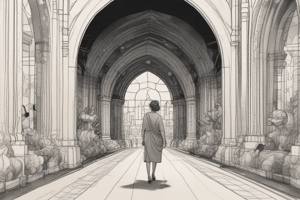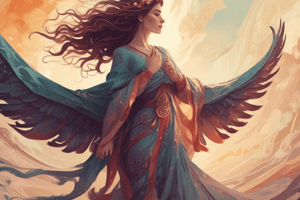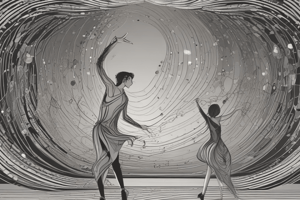Podcast
Questions and Answers
Which element of dance is associated with floor plan, direction, focus, level, dimension, and contour?
Which element of dance is associated with floor plan, direction, focus, level, dimension, and contour?
- Locomotor Movement
- Dynamics
- Space (correct)
- Rhythm
What type of movement is characterized by the momentary interruption of the continuity of the movement?
What type of movement is characterized by the momentary interruption of the continuity of the movement?
- Sustained Movement
- Vibratory Movement
- Suspended Movement (correct)
- Percussive Movement
Which term refers to the movement marked by the regulated succession of strong and weak elements?
Which term refers to the movement marked by the regulated succession of strong and weak elements?
- Dynamics
- Rhythm (correct)
- Axial Movement
- Direction
In dance, what type of movement shows a marked impulse with a completed checked follow-through?
In dance, what type of movement shows a marked impulse with a completed checked follow-through?
Which element of dance involves the use of strong and weak elements or opposite directions in movement?
Which element of dance involves the use of strong and weak elements or opposite directions in movement?
What type of movement involves continuous momentum with an unrestrained follow-through?
What type of movement involves continuous momentum with an unrestrained follow-through?
What does the term 'rhythmos' mean?
What does the term 'rhythmos' mean?
Which term refers to the force given to any beat in a measure?
Which term refers to the force given to any beat in a measure?
What is the underlying beat in a rhythmical sequence?
What is the underlying beat in a rhythmical sequence?
Which movement involves leaving the floor from one or two feet and landing on one foot?
Which movement involves leaving the floor from one or two feet and landing on one foot?
What is the term for a combination of a step and a leap in dance?
What is the term for a combination of a step and a leap in dance?
Which term describes the transference of weight from one foot to the other?
Which term describes the transference of weight from one foot to the other?
In dance, what term refers to the bending or shortening of a body part at a joint?
In dance, what term refers to the bending or shortening of a body part at a joint?
Which type of movement in dance involves a slow, smooth flowing movement with balance throughout the series?
Which type of movement in dance involves a slow, smooth flowing movement with balance throughout the series?
What dance style originated in the Italian Renaissance courts of the 15th century and serves as a backbone for many other styles of dance?
What dance style originated in the Italian Renaissance courts of the 15th century and serves as a backbone for many other styles of dance?
Which dance style focuses on the expression of inner feelings and rejects many of the strict rules of classical ballet?
Which dance style focuses on the expression of inner feelings and rejects many of the strict rules of classical ballet?
What type of movement in dance involves swinging or swaying arms forward, backward, or sideward?
What type of movement in dance involves swinging or swaying arms forward, backward, or sideward?
Which term in dance refers to striking, hitting, pulling, and pushing movements?
Which term in dance refers to striking, hitting, pulling, and pushing movements?
Flashcards are hidden until you start studying
Study Notes
Rhythm
- The term "rhythm" comes from the Greek word "rhythmos", meaning "any regular recurring, symmetry".
- Rhythm is characterized by the regulated succession of strong and weak elements, or of opposite or different directions.
Movement
- Movement is defined as motion or change in position.
- Types of movement include:
- Swinging movement: characterized by a noticeable impulse, continuous momentum, and unrestrained follow-through.
- Sustained movement: impulse and completion of movement are not easily discernible.
- Percussive movement: marked by a strong impulse with a completed checked follow-through, characterized by staccato quality and executed against resistance.
- Vibratory movement: rapid impulse with rapid relaxation, resulting in a close sequence of constructions and relaxation.
- Suspended movement: momentary interruption of the continuity of the movement, characterized by a sense of suspension.
Dance
- Dance is an art form that typically refers to movement of the body, usually rhythmic to music.
- Functions of dance include expression, social interaction, and presentation in a spiritual or performance setting.
- The three elements of dance are:
- Space: includes aspects such as floor plan, direction, focus, level, dimension, and contour.
- Dynamics: includes aspects such as measure, tempo, underlying beat, phrase, accent, and intensity.
- Rhythm: see above.
Locomotor and Axial Movements
- Locomotor movement: body travels from place to place, usually identified by weight transference on the feet.
- Types of locomotor movement:
- Walk/step: transference of weight from one foot to the other.
- Run: same as walk except the body leaves the ground between weight changes.
- Leap: same as run except the body is suspended in air between weight changes.
- Hop: leaving the floor from one or two feet and landing on one foot.
- Jump: leaving the floor and landing on both feet.
- Gallop: a combination of a step and a leap.
- Non-locomotor movement: body performs without appreciable movement from place to place, involving movements of the various parts of the body in a fixed base.
- Types of non-locomotor movement:
- Flexion: bending or shortening of the body part occurring at a joint.
- Extension: turning or twisting, circling.
- Pendular: swinging/swaying arms forward, backward, or sideward.
- Percussive: striking and hitting; pulling and pushing.
- Vibratory: shaking and beating.
- Sustained: a slow, smooth flowing movement with a balance throughout the series.
- Suspended: a sharp movement followed by a series of slow or prolonged movements.
Dance Styles
- Ballet: a formalized kind of performance dance, originated in the Italian Renaissance courts, and developed in France and Russia.
- Characteristics: uses music and dance to tell stories, emphasizes structured steps.
- Origin: comes from the French word "ballare", meaning "to dance".
- Modern Dance: a dance style that rejects many of the strict rules of classical ballet, focusing on expression of inner feelings.
- Characteristics: centers on a dancer's own interpretations, emphasizes creativity in choreography and performance.
- Origin: created as a rebellion against classical ballet in the early 20th century.
Studying That Suits You
Use AI to generate personalized quizzes and flashcards to suit your learning preferences.




